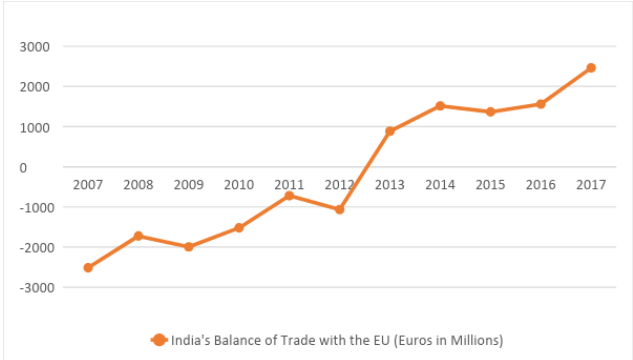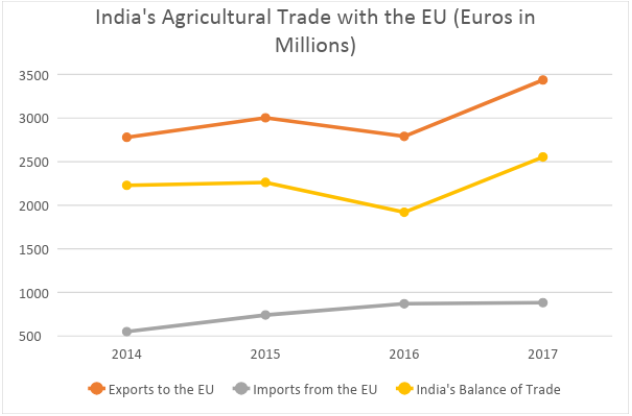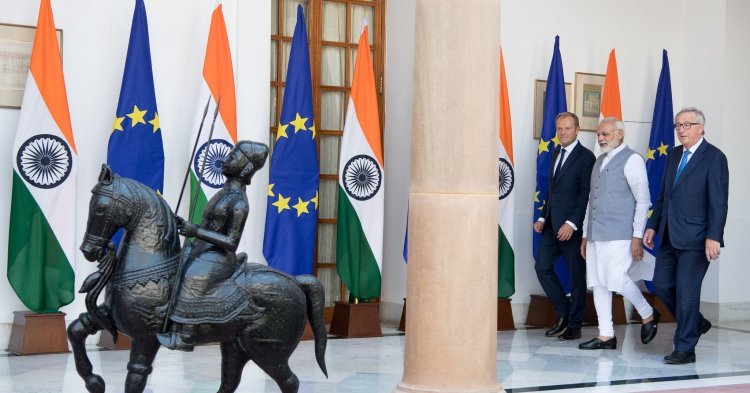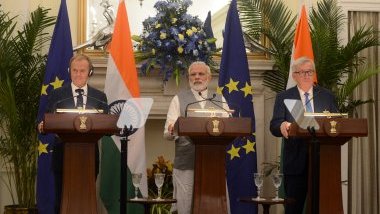However, what has plagued the negotiations previously continues to do so – the very fact that negotiations have been going on for such a long time points to a more significant difference in interests than expected. Wouters and others [1] identify five contentious issues of the EU-India FTA negotiations: (1) labour standards and movement of natural persons, (2) intellectual property protection and generic medicines, (3) subsidised agriculture and the dairy sector, (4) shared values and the trade negotiations, and (5) efficient trade negotiating and transparency. Of these, I look at (2) and (3), specifically in the sectors of agriculture, and chemicals and related products.
Why the EU and India?
Despite relations having initially developed at a slow pace, the two parties often regard each other as ‘natural allies in a wide range of global issues’. [2] Diplomatic relations were first established in 1960s and institutionalised in the first decade of the 21st century. The first EU-India summit was held in 2000 and a series of agreements followed. In 2004, both partners signed a Strategic Partnership Agreement; in 2005, they agreed on a Joint Action Plan, revised later in 2008; in 2007, they began negotiations on the EU-India Free Trade Agreement, which was projected to be completed in 2011. Collaboration has even expanded to other fields, including security and terrorism.
The EU-India FTA would be on a truly remarkable scale for bilateral trade agreements, creating a market of more than 1.5 billion consumers. In 2017, the EU was India’s largest export partner (17.2%) and total trade partner (13.0%), while being the second largest import partner (10.2%). India boasts a trade surplus with the EU, and total trade between the two economies grew 55.83% from 2007-2017, an average of 4.89% each year. This lies in contrast with India’s trade with China. While China is India’s top importer economy, India’s trade deficit with China is an ever-widening one, of US$62.93 Billion in 2017, amounting to 38.8% of India’s total trade deficit. Furthermore, when we compare the trade between the EU and India to that between the US and India, another trading partner, the EU imports more from India (US: 15.6%) and holds a larger percentage of total trade (US: 9.6%).

In terms of numbers, the EU-India FTA seems like a natural fit from the EU’s perspective as well. In 2017, India was the EU’s 9th-largest import economy (2.4%), 10th-largest export economy (2.2%) and 9th-largest trading partner (2.3%). In Asia, it is the EU’s 3rd-largest trading partner, behind China (2nd) and South Korea (8th).
Disagreements on trade in agricultural products
As mentioned earlier, I’ll focus on two major areas of trade: agriculture, and chemicals and other related products. While neither sector contributes to more than 25% of exports or imports, even when taken together, that in fact points to why they are issues of contention at the trade negotiations. Briefly, in agriculture, India has long maintained a reputation of being protectionist, while in chemicals the issue of patenting divides the two parties. I discuss agriculture in the first part below, and chemicals in the second part of the article.
In 1974, a comprehensive agreement was signed between India and the EC covering a wide range of economic issues. This was the first agreement signed by the EC with any non-associated developing country that embodied concepts of commercial and economic cooperation through trade. [3] It is perhaps rather ironic, then, that among the six working groups set up as a result of the agreement, agriculture was one of them. Despite being one of the pioneer categories of India-EU trade, more than four decades later, agriculture remains as one of the areas with the least agreement between the two countries.

At face value, we can observe a somewhat curious trend – agricultural trade seems to be negligible, from both sides. Two agricultural issues can be identified, namely commodity pricing, and global food security. [4] As for the former, it is a habit of developing countries to keep a firm hand on the agricultural sector precisely due to the fear of fluctuating food prices, should international trade and the free market be given too much reign. If the export market were overly liberalised, agricultural products would flow excessively out of the country, diluting and reducing supply back home in domestic markets.
India is surely vulnerable to such a development – a large geographical area consisting of a high population of farmers leads to a wide variety of crops being produced at large amounts. If these crops and their products are limited from flowing out of the country, domestic prices are sure to be much lower than in other economies, especially those that cannot be self-sufficient in the same way. If the export market is opened too widely, domestic supply decreases, which in turn may lead to a surge in food prices. Similar, if the import market were overly liberalised, other cheaper food and agricultural products would flow in. This fear is especially real when addressing trade with China. Cheap foreign imports threaten domestic producers and can lead to fatal unemployment problems in the face of increased external competition.
In the case of the EU, India does perceive its intentions in the agricultural market to be offensive, especially given their stance in the Doha Round negotiations. The EU subsidises its agricultural sector, which has been contested internationally. Agricultural production in the EU is artificially, through subsidies, made to have lower cost of production than would otherwise exist in a free market. India has responded to this by adopting a strong defensive stance in protecting its markets from EU agricultural imports. The results can be observed in the table above – imports of agriculture from the EU are consistently five times lower than agricultural exports to the EU.
According to some civil society actors, negotiations could be stalled on this subject alone as it is, at least by perception, an important sector to negotiators on both sides of the table. [5] However, consultation with relevant officials suggests that agricultural liberalisation would not prove to be a breaking point for the conclusion of the trade agreement. [6] Furthermore, food processing has become an increasingly important challenge for India, and in this case, European firms have a range of expertise in agri-business and food-supply chains that could help push towards an agreement.
On the issue of global food security, surveys have suggested that the 2008 spike in food prices would have been up to 50% smaller had countries not started introducing export bans. There is a clear and immense political pressure on countries like India to do so, but global food security may suffer as a consequence. At the same time, the production of bio-fuels within the EU shifts the usage of crops away from consumption, leading to global reduction of food crops. Thus, the potential of an EU-India free trade agreement, if it can balance out these two issues, could have a significant global impact.
The next part of the article will discuss contentious issues around trade in chemicals and related products. Find it here.


Follow the comments: |
|
